BEST WAY TO SIT ON THE TOILET WHEN CONSTIPATED - 5 GUIDELINES
- Medically reviewed by: Horia Marculescu, MD
- Photo credits: Licenses / Author
- Last updated: 30.01.2024
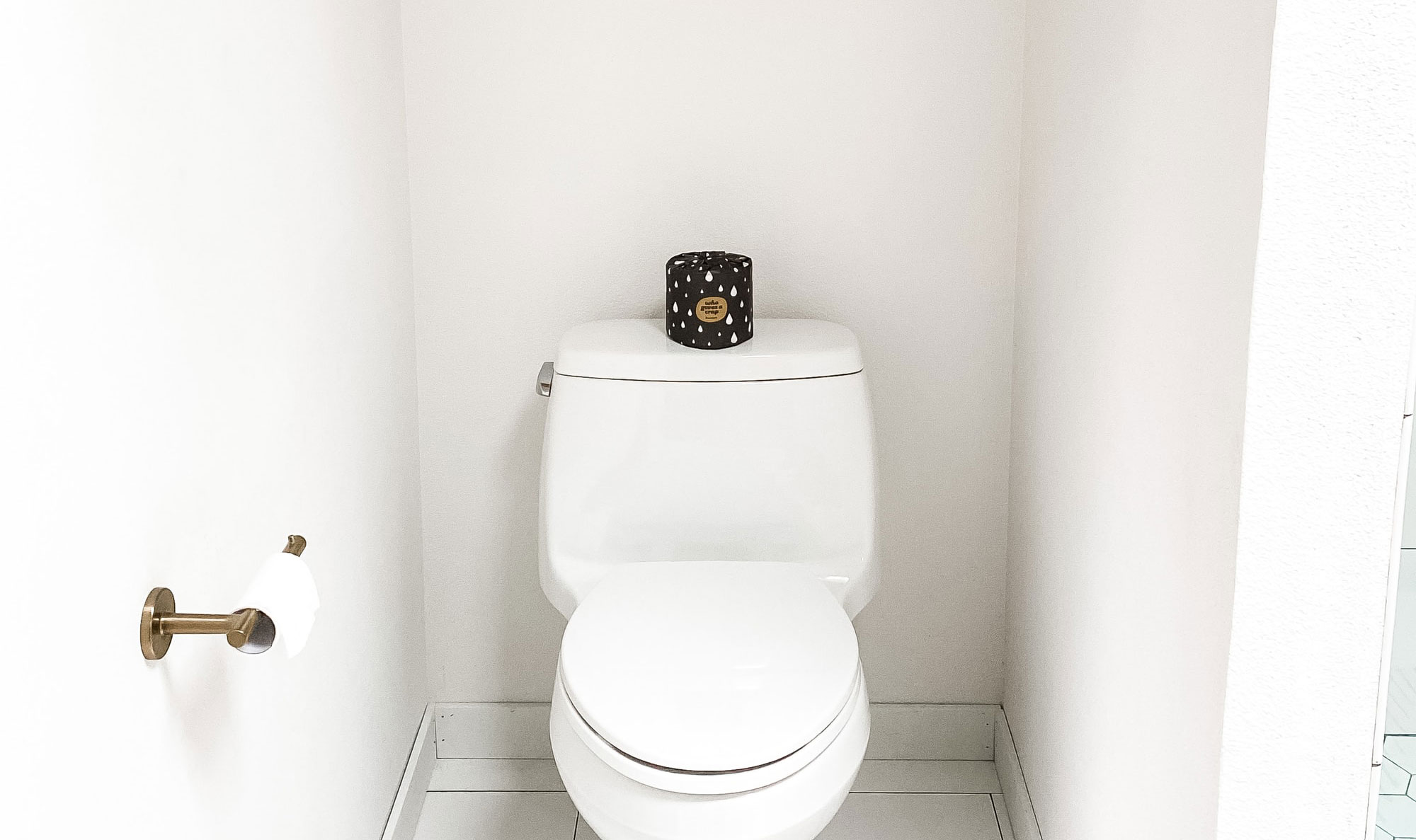
The Semi-Squat posture is the best way to sit on the toilet when constipated because it relaxes the puborectalis muscles and unlocks the kink at the entrance of the rectum.
It also increases the anorectal angle and relaxes the sphincter. After defecation, the anorectal angle will decrease, and the kink locks again to prevent incontinence.
Use a footstool to raise your knees higher than your hips.
This way of sitting on the toilet bowl is essential. It helps to have stool evacuation often. And without much effort. For better results, squatting before going to the toilet is recommended.
1. THE SEMI-SQUAT WAY
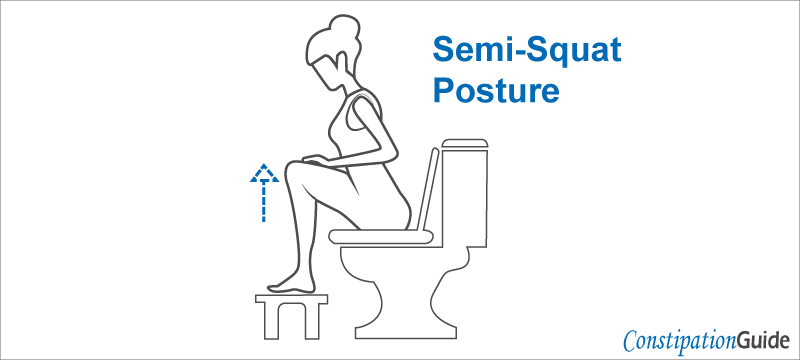
The semi-squat position is the best way to sit on the toilet when constipated because it starts to relax the puborectalis muscles and the anal sphincter.
In this position, the kink at the entrance of the rectum will unlock, and the anorectal canal will have a clear path for the stool to move. After defecation, the anorectal angle decreases, and the kink at the entrance of the rectum will lock itself.
Locking the kink is natural, and it prevents leaks and fecal incontinence. The only unnatural way to have stool evacuation is to keep the kink locked.
Keeping the kink in this way is usually a consequence of staying at a desk for long periods with the knees at the same level as the hips.
Also, the anorectal muscles and the hips will numb. This thing means that blood circulation and motility in this area will suffer.
If you want to learn about toilet and constipation relief in the long term, it is necessary to know how semi-squatting works.
What is the semi-squat posture?
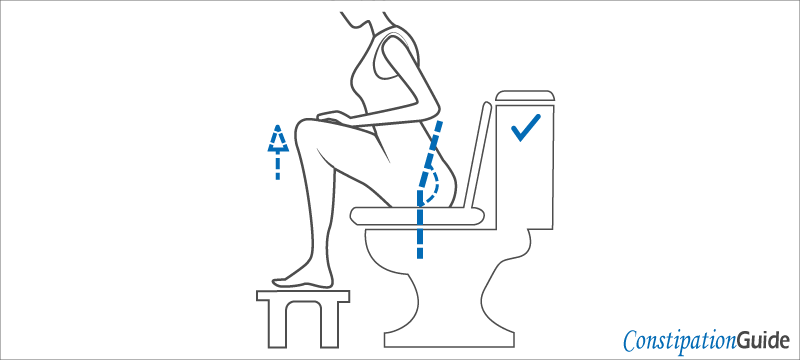
The Semi-squatting posture is a way to combine ordinary squatting with the modern way of sitting on the toilet bowl.
It takes the typical posture from sitting on a chair with the hips and bottom on the upper seat.
This posture simulates the squat posture that raises the knees higher than the hips.
It is an excellent combination that releases tension from your bottom, intending to move the stool inside the large intestine.
The differences between squatting and semi-squatting are:
- Your bottom sits on the toilet seat.
- The heels sit on the footstool.
- The entire soles of the feet stay on the footstool.
People invented semi-squatting out of necessity in the modern era.
The typical way that most people use when defecating does not relate to that from ancient times. In ancient times, people were eliminating the stool in a primitive way.
Place a low-rise footstool near the toilet bowl.
First, place a low-rise footstool in front of the toilet bowl.
Turn your back and put your foot on the footstool. Next, place the second foot and keep balance. Lower your body slowly until it reaches the toilet seat. It is that easy.
Now, stay in this way for 1-5 minutes. Stay until you feel your bottom relaxed enough for stool evacuation.
If it takes longer than five minutes to have stool evacuation, then stay in this way for five more minutes.
If nothing happens after 10 minutes in a semi-squat way, move away from the toilet and try again later.
Here is an interesting example. Put a footstool under your desk. Keep your feet higher than your hips while you are working or studying.
When you eat, you can also place a footstool under the table.
Eating while standing on your feet is better because it releases the tension inside the intestines.
What do the health experts say about the semi-squat posture?
According to The Department of Colorectal Surgery, Cleveland Clinic:
“The Thinker position seems to be a more efficient method for defecation than the sitting position. This technique may be helpful when retraining patients with constipation. ”
The conclusion in 2016 was that the semi-squat way of sitting on the toilet (under the form of The Thinker position) helps defecation in patients suffering from constipation.
“When sitting on the toilet, it may be helpful to make sure the knees are bent above, the level of the hips, and the feet are flat on the floor. A small footstool under the feet may be necessary to get the best position.”
According to a study about American toilet design by Barbara Penner:
“Noting the medical view that the optimal posture was a squat, Kira proposed a semi-squat water closet with a redesigned seat that supported the ischial tuberosities and brought the knees above the seat level, which would gradually strengthen abdominal and upper leg muscles.”
The references (Alexander Kira’s The Bathroom 1976) and the research (trusted source 1, trusted source 2, and trusted source 3) include the variations in the distribution of weight borne by buttocks, according to sitting height and posture.
There is a comparison of seat shapes and their effect on spreading the buttocks. The conclusion was that the Semi-Squat posture had the best results.
2. BENEFITS OF THE SEMI-SQUAT POSTURE
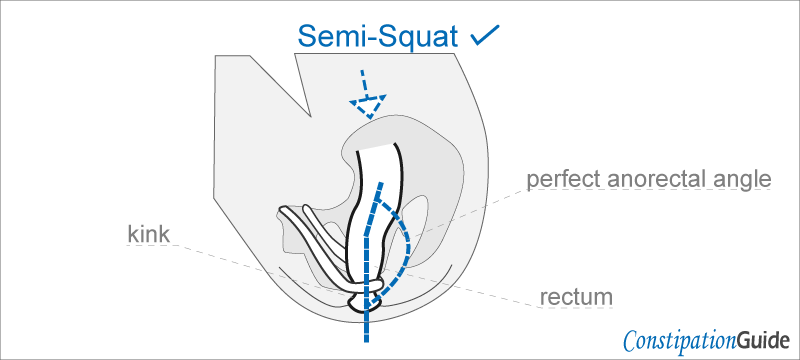
The Semi-Squat posture is the best way to sit on the toilet when constipated because it makes the anorectal and puborectalis muscles create a clear path for the stool to move.
Using this posture, you will be able to:
- Have stool evacuation often.
- Have stool evacuation without too much effort.
- Have less abdominal and rectum straining.
- Create a quality defecation routine.
When the body learns to squat and recognize this way of sitting on the toilet bowl, it will naturally relax the puborectalis muscles.
The more often the body is in the semi-squat position, the better it will handle defecation.
This way of sitting on the toilet is an excellent remedy. It prevents numbness.
And it helps people who get stuck on the toilet bowl.
People who stay longer than five hours at the desk or in a car can use this position to keep the blood flow active.
Putting too much pressure on your abdomen and rectum will require you to squeeze them even more.
Squeezing the abdominal muscles and rectum will cause even more numbness.
Squeezing hard is not great for evacuating the stool.
To benefit from constipation relief when visiting the toilet often, squeezing and straining hard are not recommended.
Here is a way to sit on the toilet bowl without using a low-rise footstool:
- Position yourself on the toilet seat.
- Raise your heels as much as you can.
- Stay in this way for 1-2 minutes.
- Take a pause.
Repeat these steps 1-3 times until you get the desired result. The aim is to relax the puborectalis muscles and to open the kink at the entrance of the rectum.
If your heels and ankles feel numb, then take a break.
“Lay down and stand with your feet slightly apart or in a stride stance. Get in the semi-squat position with your hands resting on your knees as you lean forward slightly.”
The guide presents the Semi-Squat posture as an alternative way to improve pelvic floor muscles and blood flow. Also, the main benefit of pelvic floor exercise is that it improves bladder control.
3. THE MODERN WAY TO SIT ON THE TOILET BOWL
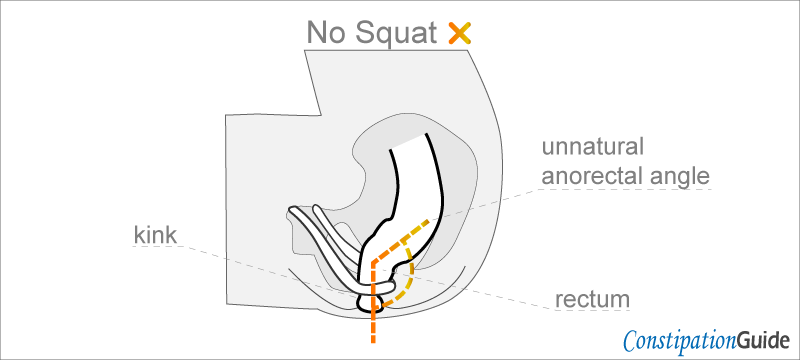
The semi-squat posture is the best way to sit on the toilet when constipated.
The typical way brings the knees to the same level as the hips.
It could also be with the knees a bit higher than the hips.
Usually, this thing happens when the toilet bowl is smaller than usual.
Sitting with the knees lower than the hips is not that great. It puts too much pressure on the bottom and hips.
This thing happens when the toilet bowl is larger than the typical size.
The typical way of sitting on the toilet bowl is not great if you suffer from constipation.
The majority of people who stay at the office desk from 9-5 and suffer from constipation have a hard time when it comes to stool evacuation.
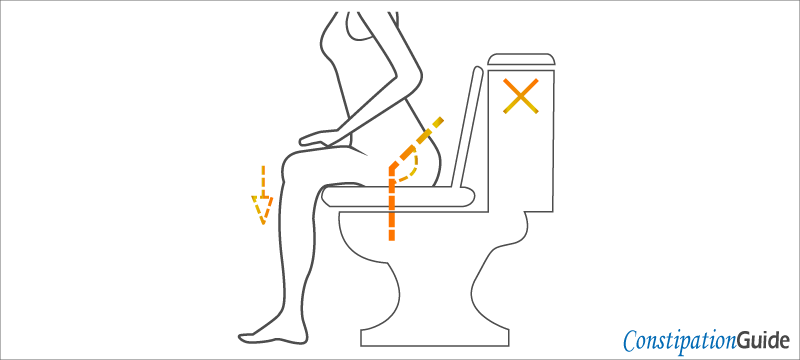
This thing also applies to:
- Drivers who stay in their cars for longer than five hours.
- People who have to write all day.
- Kids at school who learn 5-7 hours and they can’t do exercise.
- People who can’t move because of injuries.
They put too much pressure on the sphincter, anorectal canal, and the blood flow.
This way of sitting does not affect the way they have stool evacuation.
This thing happens because they have proper intestinal transit and motility. Somehow, they manage to relax the puborectalis muscles and sphincter.
It is in their genes, or they do some kind of movement, unaware of them.
If you can’t have a low-rise footstool where you work most of the time, at least take your time at home and sit on the toilet in the correct position.
“The sensation of satisfactory bowel emptying in the sitting defecation posture necessitates excessive expulsive effort compared to the squatting posture.”
“Pelvic Floor dysfunction - usually occurs due to the failure of the pelvic floor muscles (including the anal sphincter) to relax appropriately during evacuation efforts, thus making stool passage much more difficult.”
The study published by The International Foundation for Functional Gastrointestinal Disorders explains that persons with pelvic floor dysfunction tend to have a defect in the coordination necessary for defecation.
This defect is a functional outlet obstruction.
4. THE COMPLETE SQUAT WAY TO SIT ON THE TOILET
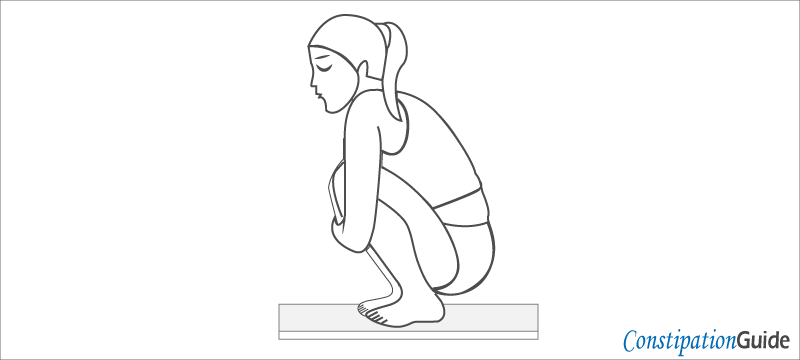
The complete squat posture is a great way to prepare for stool evacuation. For most of us, the total squat posture requires a place where people are comfortable.
Sitting on an Indian toilet bowl using this posture relaxes the bottom. This action is the best way to sit on the toilet when constipated.
But unfortunately, for 99% of people, this thing is impossible in everyday life.
We can rarely find Indian toilets or Turkish toilets. And if we find an Indian toilet, it is usually a dirty place.
If you have a Turkish or Indian toilet bowl, then you don’t need much to do. Lower your body and position the rectum above it. And stay focused to keep balance.
View the squat posture as a way of preparation. You should squat 15-30 minutes before you go to the toilet, even if you stay in a typical way on the toilet bowl.
How to squat?
- Stand on your feet straight.
- Keep a foot distance between your legs. Lower your body until your knees are higher than your hips.
- Stay like this for 1-3 minutes.
Now, take a break for one minute. Repeat the step twice and take a five-minute break. It is that easy.
Stay in this position for 15 minutes.
The squat posture should come naturally and easily. If you feel soreness and numbness in your hips and knees, take a break and relax.
When you go to the toilet, constipation relief and defecation should come naturally using this guide with these simple techniques.
The main thing to keep in mind is to relax the puborectalis muscles and the anal sphincter. These are the only things that matter when you practice squatting.
Try to have a ten-minute break once every hour. This thing means to stay on your feet or walk gently. The idea is to relax your bottom and keep the blood flow going.
Ideally, it would be great to have a ten-minute break every hour. But not more than ten minutes every two hours.
Here is an example. If you stay at the desk for longer than 5 hours daily, you can squat in the middle of the program.
After 3 hours, you can take a break before eating lunch. Walk for 10 minutes, and after that, squat for another 5 minutes.
Combine these two techniques in an empty room with no one around. After these exercises, you can eat while you stand on your feet. Try to focus and feel what happens in your belly.
According to a medical study called Influence of Body Position on Defecation in Humans:
“The results of the present study suggest that the greater the hip flexion achieved by squatting, the straighter the rectoanal canal will be, and accordingly, less strain will be required for defecation.”
5. OTHER WAYS TO SIT ON THE TOILET BOWL
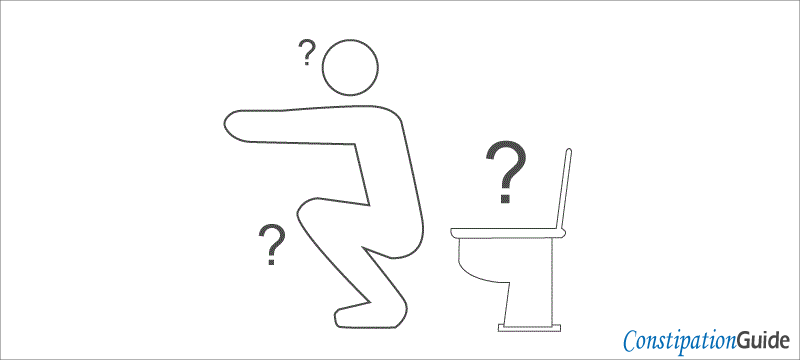
Are there any other ways to sit on the toilet when constipated?
Toilet bowls limit the way people sit on them. The only ways to sit on the toilet bowl are the semi-squat posture and the complete squat posture.
The body posture has to be similar to the squat posture.
A standard toilet bowl makes the body posture not ideal for stool evacuation.
It is impossible to sit in any other way and have proper stool evacuation because:
- The kink at the entrance of the rectum locks itself.
- The kink unlocks only when the anorectal angle increases.
- The puborectalis muscles feel pressure if you don’t relax them enough.
Our body reacts to our thoughts. It is helpful to think of ways to prepare and improve stool evacuation.
Here is an example that includes the intake of warm liquids.
Drink hot tea before deciding to visit the restroom. This way of preparing bowel movements is excellent because it creates pressure inside the intestines.
Chicory has laxative effects. So, a glass of warm water and chicory might be a great way to improve bowel movement.
If you suffer from severe constipation for more than three months, then it is time to see a doctor. You will need to take some blood and stool tests. This thing helps you and the doctor establish a diagnosis.
The guidelines presented in this publication cannot replace the recommendation and the diagnosis of a certified board member doctor.
Gently practice the squat posture if you suffer from high blood pressure.
According to a study called Squatting, blood pressure, and stroke:
“Changes noted above on squatting appear to be more than fortuitous. We would suggest that hypertensive subjects and those at risk of stroke should avoid squatting and urge physicians to check squatting BP while monitoring anti-hypertensive therapy.”
The authors concluded that this position could affect patients who are hypertensive or are likely to develop stroke. 3
The Semi-Squat posture is the best way to sit on the toilet when constipated because it relaxes the bottom. It creates pressure and a clear path for the stool to move towards evacuation.
It is easy to use with or without a footstool. And it is even more effective when your squat before you poop. So, the entire puborectalis muscles and sphincter relax.
Last medically reviewed on 30.01.2024
TRUSTED SOURCES
1. The functional gastrointestinal disorders and the Rome III process. Douglas A Drossman.
